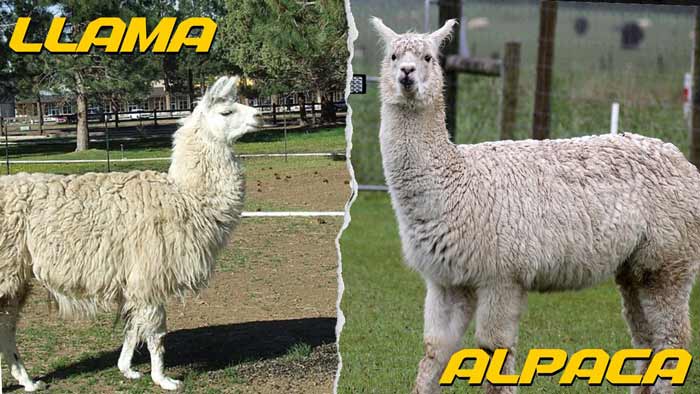In the highlands of the Andes, two fascinating creatures capture our imagination: the alpaca and the llama. Though they may look similar, these members of the camelid family have distinct qualities and roles.
This article delves into the differences between alpacas and llamas, shedding light on their unique characteristics and importance in their native habitats.
Quick Overview
| Alpaca | Llama | |
|---|---|---|
| Size | Smaller, 36 inches at shoulder, 100-175 pounds | Larger, 42-46 inches tall, 280-350 pounds |
| Ears | Short, pointy ears | Long, banana-shaped ears |
| Face | Short, rounded with more fur | Longer with less fur |
| Fleece | Finer, softer, used for high-quality textiles | Coarser, used for ropes and rugs |
| Temperament | Shy, prefers being in a herd | More independent, can act as guard animals |
| Uses | Wool production | Pack animals, guarding livestock |
| Lifespan | Typically 15-20 years | Typically 15-20 years |
| Diet | Herbivores, feed on grasses and hay | Herbivores, feed on grasses and hay |
Size
Alpacas are considerably smaller and more delicate when compared to llamas. They stand about 36 inches at the shoulder and weigh between 100 and 175 pounds. This smaller size makes alpacas less intimidating and more suitable for smaller farms or personal care.

Llamas, on the other hand, are significantly larger, with height between 42 – 46 inches. They weigh between 280 to 350 pounds, making them more robust and suitable for heavier tasks, such as being pack animals.
Ears and Face
One of the most noticeable differences between alpacas and llamas is in their ears and facial features.

Alpacas have short, pointy ears and a short, rounded face, often covered with a significant amount of fur. This gives them a teddy bear-like, endearing appearance.
Llamas possess long, banana-shaped ears and a longer, more pronounced face with less fur. Their elongated face and less fluffy appearance give them a more regal and imposing look compared to the alpacas.
Coat and Wool

The coat of an alpaca is finer and more luxurious, making it highly valued in the textile industry. Alpacas boast a wide range of 22 naturally occurring coat colors, offering a spectrum from white to black and various shades in between.

Llamas have a coarser wool coat, which is typically used for making ropes and rugs. They come in various shades of solid colors and spotted patterns, including white, black, gray, beige, brown, and red.
Behavior
Alpacas are known for their shy and reserved nature. They prefer the safety and comfort of their herd and communicate with each other using subtle body language and soft humming sounds.
Llamas exhibit a more independent personality. They are generally gentle and calm, making them suitable for interactions in petting zoos and as therapy animals. However, llamas are also known to express their displeasure more openly through actions like spitting or kicking, especially if they feel threatened or mistreated.
Gestation and Offspring
The gestation periods of alpacas and llamas are quite similar, despite their size differences. Alpacas have a gestation period of approximately 335 to 350 days, while llamas have a slightly longer gestation period of 342-355 days.

Baby llamas, or crias, typically weigh between 20 to 35 pounds at birth, whereas baby alpacas are much smaller, usually weighing between 10 to 17 pounds. This difference in birth weight is reflective of the adult size differences between these two species.
Uses
Alpacas are primarily bred for their fleece, which is used in creating high-quality, luxurious garments. Their softer and finer fleece makes them particularly valuable in the textile industry.
Llamas have traditionally been used as pack animals due to their larger size and greater strength. They are capable of carrying significant loads over long distances.
Additionally, llamas are often employed as guard animals on farms, where they protect smaller livestock like sheep and even alpacas from predators.
Conclusion
Alpacas and llamas, each with their unique size, ear shape, facial structure, coat texture, personality, and utility, play vital roles in their native habitats and in various human contexts.
Understanding these differences is crucial for anyone interested in these animals, whether for farming, textile production, or simply appreciating the diversity of wildlife.
Both species, with their distinct attributes, contribute significantly to the cultural and economic aspects of the regions they inhabit.
FAQs
Alpacas are smaller, have finer fleece, and are primarily bred for their wool. Llamas are larger, have coarser coats, and are often used as pack animals or for guarding livestock.
Yes, alpacas and llamas can interbreed. Their offspring, known as huarizos, inherit traits from both parents.
Alpacas are smaller with a more delicate build, have softer fleece, and shorter, pointy ears. Llamas are larger, have longer faces with less fur, and their ears are long and banana-shaped.
It depends on the purpose. Alpacas are better for wool production due to their softer fleece, while llamas are more versatile for tasks like carrying loads and guarding other animals.
Alpacas are generally shy and prefer to be in a herd. Llamas are more independent and can be used as guard animals due to their confident nature.
Yes, they can coexist peacefully, especially if raised together from a young age. However, their different needs and temperaments should be considered.




